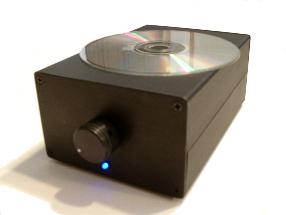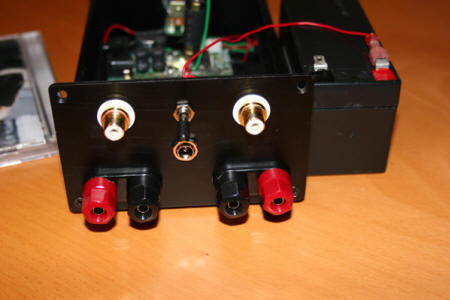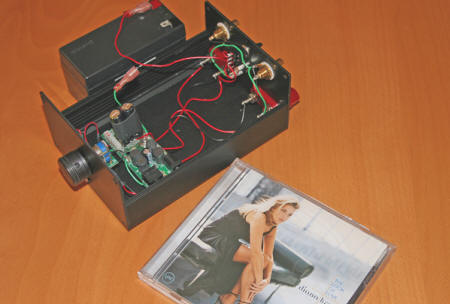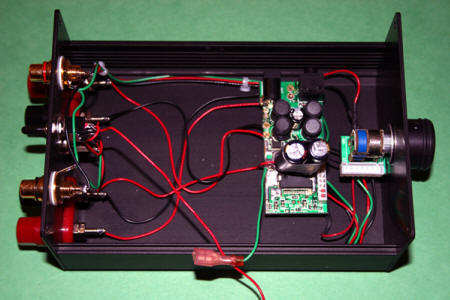You are reading the older HTML site
Positive Feedback ISSUE
18
march/april 2005
red wine audio
Clari-T-Amp amplifier
as reviewed by Gary Beard and Ed Morawski

|
GARY L. BEARD'S SYSTEM
LOUDSPEAKERS
ELECTRONICS
SOURCES
CABLES
ACCESSORIES
|
 Those of you who frequent internet audio forums are
probably familiar with Red Wine's owner, Vinnie Rossi. He has been one of the
more cyber-visible hotrodders of things digital for some time. An electrical
engineer by profession, Vinnie has a great love of audio, and recently cut the
purse strings of a day job to start making his own audio gear. Rossi's first
commercial product, christened the Clari-T-Amp, is a battery-powered amplifier
based on a highly modified Sonic Impact Tripath amplifier. It is no secret that
the little SI amp has taken the low-budget audio community by storm. Rossi saw
great potential in the SI amp, which is based on the Class-T digital chip
invented by Tripath Technology, and has modified it into something way beyond an
inexpensive digital chip housed in a plastic box. Because Red Wine Audio is one
of many new kids on the audio block, I asked Vinnie to tell me about the Clari-T-Amp
and his new business enterprise:
Those of you who frequent internet audio forums are
probably familiar with Red Wine's owner, Vinnie Rossi. He has been one of the
more cyber-visible hotrodders of things digital for some time. An electrical
engineer by profession, Vinnie has a great love of audio, and recently cut the
purse strings of a day job to start making his own audio gear. Rossi's first
commercial product, christened the Clari-T-Amp, is a battery-powered amplifier
based on a highly modified Sonic Impact Tripath amplifier. It is no secret that
the little SI amp has taken the low-budget audio community by storm. Rossi saw
great potential in the SI amp, which is based on the Class-T digital chip
invented by Tripath Technology, and has modified it into something way beyond an
inexpensive digital chip housed in a plastic box. Because Red Wine Audio is one
of many new kids on the audio block, I asked Vinnie to tell me about the Clari-T-Amp
and his new business enterprise:
JLB: Please tell me about your new company, Red Wine Audio.
VR: I am an electrical engineer. Before this, I worked in the telecom (high speed fiber-optic laser transmitters and receivers) and GPS navigation (marine electronics) industries as an electrical test engineer. I have been very passionate about home audio and electronics since I was an early teenager, and I knew it was only a matter of time before I would decide to start a career in it.
I established Red Wine Audio, Inc. in early February 2005, with the goal of offering home audio products as well as custom modification services for the audiophile who is seeking simplicity, high performance, and strong value, combined with unsurpassed customer service. We take a straightforward, "less is more" design approach in order to recreate music with absolute clarity and purity. We plan to offer new battery-powered products such as CD transports, DACs, and amplifiers. These products will feature simple designs and "a la carte" customization options, and we will also be offering competitive modification services to non-battery-powered equipment.
JLB: What design modifications are made to the Clari-T-Amp?
VR: I would love to have the Clari-T-Amp removed from association with the SI, but in all fairness, the Clari-T uses a highly-modded SI board. Without going into the exact details of the modification secrets, I'll say this:
(1) The 12V power wire is soldered directly to the tiny input power pins of the TA2024 chip (point-to-point wiring). This provides the cleanest and most direct power path to the chip, reducing noise as well as the series resistance and inductance found in typical board traces. I also add two low-ESR power supply decoupling capacitors. These large, through-hole caps are delicately soldered directly to the tiny surface-mount pins of the TA2024 chip. The total power supply capacitance is increased by a factor of ten, and the added capacitors are bypassed with surface-mount caps. This very direct power routing and decoupling/bypassing of the power line to the TA2024 chip gives the Clari-T-Amp its lightning-fast transient response, among other distinctive attributes.
(2) The input signal is sent directly to a
"shunt-mode" tweaked pot, where only one resistor is actually in the signal
path. The potentiometer is simply used to
shunt a portion of the signal to ground (which varies with knob position). The
signal from the volume control is wired directly to the amplifier board. There
are
no signal-degrading connectors in the signal path, and the signal wires are
routed away from the output filter to minimize noise.
(3) A 12V 1.3Ah SLA (Sealed Lead-Acid) battery powers the Clari-T-Amp. This battery has the advantages over an AC/DC power supply of having a noise-free high-current output, small size (portability), and simplicity. You will no longer need to be concerned with the complexities and expense associated with power conditioners and power cords! Music arises from a completely black background. This only serves to enhance the Clari-T-Amp's ability to unbundle individual instruments from even dense mixes.
(4) The Clari-T's black anodized aluminum enclosure was chosen for its small size, solid construction, smooth looking appearance, and most importantly, electrical noise shielding properties.
The question for the reviewer is: What does all this technology sound like? The answer is that the Clari-T-Amp doesn't sound like any solid-state amp I've owned, and it doesn't sound like any tube amp that has graced my ears either. Perhaps it could be said that there is a sonic similarity to my digital Panasonic SA-XR50 receiver, yet the Clari-T is much more refined. Truth be told, I am really struggling to find a way to describe the sound of this amp. I guess I could start by taking a page from Rossi's name for the amp—Clari-T. Yes, this amp does indeed provide clarity, and beyond that, it is the quietest amp I have ever not heard. Musical sounds develop unhindered by a high noise floor. Imagine stars in the ultimate void of space. Just as we see them at their brightest in a very dark night sky, so too does the sound of the Clari-T-Amp shine brightly from within its quietness. It is an overworked audio cliché to say that the music emerges from blackness, but in this case it is more like music escaping from the event horizon of a black hole.
I used a host of budget-priced partnering equipment—my own Pioneer 578A universal player and Slim Devices Squeezebox music server, an Audio Note 1.1x Mark II DAC, and mini-monitors by Audio Note, Omega, and Nola. To be fair, the DAC and speakers were new, so there were sonic changes as time passed. I listened to many different kinds of music, in two different rooms—a cramped 10 x 10-foot cube of an office and a 19 x 12-foot living room.
Early on, I noticed some things about the sound of the Clari-T-Amp that I did not like. It had a tendency to emphasize the upper midrange and lower treble, which created a noticeable leanness in the midbass. The upper treble was harsh and grainy, and the soundstage was wide but flat as a pancake, and lacked the dimensionality and bloom that I like. The bass was good, but somewhat light. These early impressions only served to confuse, and as I continued to get familiar with the amplifier, I realized that it was giving me nothing more than what the recording could give. I also found that the amp needed to be warmed up for a minimum of thirty minutes before listening critically. When partnered with the finicky Fostex drivers in the Omega Grande 6 speakers, it took a good hour of playing music for the amp and speakers to start sounding their best. After the warm up, it was like I was listening to a whole new system.
The Clari-T is extremely transparent, and although there was occasional harshness in the treble on poor recordings, it is a smooth operator. It may produce just six little watts at 8 ohms, but it can drive sensitive speakers without breaking a sweat. It got VERY loud very quickly when driving the 95dB Omega Grande 6s (see Omega for Gary's review). This is not necessarily a flaw, just a fact. It drove the 90dB Audio Note AX-2 Signatures very well, and to my surprise, it sounded fabulous with the 88dB Nola Minis. I could easily hear each speaker's strengths, which is as it should be. Both the Omegas and the Audio Notes were terrific in the extreme nearfield of the small room, with spectacular imaging and immediacy, but the Clari-T/Nola combination rocked the bigger room with a huge soundstage, very good bass, and sparkling highs. Although the amp would run out of juice at times, it sounded great nonetheless.
Because of their efficiency, the Omega Grande 6s were clearly the best partners with the Clari-T. I am not going tos give you a microscopic description of a few musical tracks, as my new "Music First" mantra says that is a no-no. I now listen for fun (as we all should), and my notes are about my musical, not my audio experiences. While listening to Telarc's great recording of the Cleveland Symphony playing the 1812 Overture, I was thrust into its galloping pace and explosive dynamics, and the wide soundstage showed off the majesty of scale that only a great classical piece can deliver. Switching gears, John Hiatt's wonderful acoustic guitar work and deep, growling vocals on the CD Crossing Muddy Waters were terrific, and seemed pitch perfect to me (having heard Hiatt live a couple of times). Lastly, a comment about one of my favorite 1970s gems—the MoFi version of Loggins and Messina's wonderful Full Sail. The amp showed off the mellow tone of the steel drums, the great guitar work, the catchy island rhythms, and the beautiful vocal harmonizing. Very nice work, Clari-T!
The Clari-T has excellent bass control and a punchy, dynamic sound. I felt it sounded better in the bigger room, where the additional space allowed me to turn the volume up to a point at which dynamic contrasts were more noticeable. While its soundstaging and imaging are very good, the Clari-T sounds a bit recessed and flat at lower volume levels. If you feel that soundstaging and imaging are hi-fi artifacts, you probably won't even notice. As I said earlier, the Clari-T doesn't sound quite like any other amp I've experienced. It certainly does not smother music in euphonic sweetness, nor does it have the surgical-steel precision of some solid-state amps. It has its own sound, one that is a bit on the analytical side perhaps, yet is oddly embracing and musical. It is neither warm nor cold, and it has great detail, excellent inner resolution, and realistic tonality. You might say it presents a Class-T version of musical truthfulness.
The review sample had only about thirty hours use before it arrived at my home, so the harsh treble I heard at first could have been due to insufficient burn-in time, and/or the peaky hardness of relatively new Fostex drivers. Because of the battery-charging requirements, putting hundreds of hours on the amp prior to a review was nearly impossible, so I didn't even try. That said, the Clari-T's high frequencies smoothed out and the bass became deeper and more present during the review period, so it is likely that the amp will sound even better for the next PFO reviewer. I did not have a preamp to mate with the Clari-T, so I can only wonder what a bit of active tube magic might do for it. It might have better dynamics at low volume, additional depth and dimensionality, and warm up just a touch, to round things out. Those would be my wishes.
I should note that the SLA battery system worked flawlessly, but a prospective owner must be aware of its care and feeding. It is simple to use as long as you remember to turn it off after 4-6 hours, and the battery must be replaced every couple of years, depending upon the amount of use and your charging habits.
Considered solely on its sonic merits, the Clari-T-Amp is a really terrific. I could live with one from now on and not feel I was missing anything important to the soul of music. It would make a great amp around which to build a low-cost, high-quality audio system. It isn't perfect, of course. It doesn't have the midrange bloom I love, nor does it reproduce space quite as well as my favorite amps. It may seem a bit distant to lovers of warm and cuddly sound. Its virtues include its quiet clarity and excellent inner resolution, which make it a bona fide contender in the low-budget/high-value ring. If you forget that the Clari-T begins its life as a $30 plastic wonder, you will appreciate the high value of this amp. It will not be everyone's jug of vino, but with the right speakers and a good source it may cultivate your vineyard. If you consider Red Wine Audio's trial period as incentive, you might find it to be the sonic equivalent of discovering a truly outstanding Cabernet for $7 in the bargain bin. Gary L. Beard
|
ED MORAWSKI'S SYSTEM:
LOUDSPEAKERS
ELECTRONICS
SOURCES
CABLES
ACCESSORIES
|
 The audiophile world may be one
of the last in which tiny start-up manufacturers can compete with huge
multinational corporations in the same marketplace. Someone with a new idea (or
a new twist on an old one) can start his or her own business and turn out
low-volume, practically custom-made products and make a living doing what they
love. Of course, it won't be easy, but in these days of websites and internet
marketing, a one-person operation can seem like a giant, well established firm.
The audiophile world may be one
of the last in which tiny start-up manufacturers can compete with huge
multinational corporations in the same marketplace. Someone with a new idea (or
a new twist on an old one) can start his or her own business and turn out
low-volume, practically custom-made products and make a living doing what they
love. Of course, it won't be easy, but in these days of websites and internet
marketing, a one-person operation can seem like a giant, well established firm.
I don't know the history behind Red Wine Audio, but I suspect it is a small operation. I exchanged a few emails with Vinnie Rossi, who seems to be the principal of the company, and got refreshingly fast responses and great customer service. Red Wine produces the Clari-T-amp, which has been getting a fair amount of buzz on the chat forums, where many have compared it to a SET amplifer or the Gaincard because of it 6-watt output. Yes, this is yet another digital amplifier based on the Tripath chipset!
The Clari-T-Amp arrived in a compact yet hefty (4-pound) box from fellow reviewer Gary Beard. It is an interesting and unusual design, as it uses only battery power during normal listening. In fact, one pound of its weight is the wall wart that charges its internal battery. The amp is contained in a compact (4 x 6 x 2.5-inch) anodized metal box. It is so small that the speaker binding posts and gold-plated RCA inputs take up most of the rear panel, along with the connection for the battery charger and a toggle switch. The Clari-T also has its own volume control for use without a preamp.

The charger has a two-color LED that is red when the battery is being charged and green when it is fully charged. After confirming that the battery had enough charge, I flipped the rear toggle switch to battery operation, turned the volume control to the "On" position, and was rewarded with a blue LED indicating that the unit was powered. I fed the Clari-T directly from my Musical Fidelity NuVista CD Player using Xtreme Audio interconnects. The Clari-T drove my DIY speakers, which are rated at a 6-ohm impedance. I used Analysis Plus Oval 9 speaker cables.
Alison Krauss' Forget About It was in the player, so that was the first CD I played. The first thing I noticed was that the Clari-T sounded somewhat sterile. Another obvious characteristic was its narrow soundstage, which was only as wide as the distance between my speakers. With my reference DK Design VS-1 amp, it had been much wider and deeper. After a few minutes of adjusting to the amp, I could hear that it had extremely high resolution, but I also have to report that it emphasized the highs over the rest of the range. Gone from my system was the richness I normally hear on this CD, and Krauss' glorious voice was somewhat lacking.
Knowing that every new component takes some getting used to, so I spent the next week playing favorites like Loreena McKennitt and Diana Krall. I listened every day when I arrived home from work. After a week, I was still distracted by the sterility of the Clari-T. While it had amazing detail and effortlessly powered my speakers to deafening levels, I had a tough time coping with the absence of richness I crave in the midrange, especially in the vocal spectrum. While the amp reproduced the brushes and cymbals on Krall's "Look of Love" in incredible detail, I felt no emotion. The notes were clean but sharp, which may have been the source of my feelings. I love high resolution and crave detail, so the Clari-T should have been right up my alley, This perplexed me, so I gave the Clari-T much more time than usual. I generally form sonic opinions very quickly, but I had a hard time pinning down this amplifier. Don't get me wrong—the Clari-T sounded really good. It was full range, smooth, and even. At first I thought that the amount of detail was making it sound hot, but in retrospect, I decided that the Clari-T sounded sterile because it was so clean.

It also does a pretty good job in the bass department. Lows were clean and rather stout for a 6-watt amplifier. The Clari-T easily puts SET amps to shame in the low end. Madonna's American Life has plenty of bass, and never once did I find the Clari-T lacking in that department. I can also say that I never craved more power, even when listening to rock and orchestral works.
The Clari-T is tiny for a reason. The TA2024 amplifier board is only about 1 by 2 inches! It is apparent that Red Wine Audio sourced the board from some other component, possibly an electronic keyboard or boom box, since it contains a power socket and on/ off switch that the Clari-T does not use (Red Wine wires directly to the board and adds their own power switch and power connector). Normally, I would be somewhat offended by this, but Red Wine charges a very fair price for the amp. At only $499, I doubt Vinnie is making much profit.

Red Wine says the battery should last six hours on a charge, and while I cannot confirm this, I did listen for hours without having to recharge. My usual practice was to listen for several hours, then recharge the battery overnight to be ready for the next day's use. This was never a burden, but if you forget, it will take an hour or so for the amp to recharge before you can listen again.
At this point I decided to try running the Clari-T with my pre-amp- an E.A.R. 864 with tubes to see if those would indeed make a difference. Now who would mate a $3000 preamp with a $500 power amp? Maybe no one but it would at least give us an idea if perhaps a less expensive tube pre would enrich the sound. Red Wine does offer a monoblock version of the Clari-T, which could be very interesting if you went in this direction. You can also order your Clari-T (mono or stereo) without the volume control for this purpose.
When I played a few Alison Krauss tracks again, this time there was more tonal richness than before. The overall sound was still laid back but not nearly as sterile. The soundstage improved slightly as did the imaging but varied quite a bit between tracks. For instance on "Stay" from Forget About It, all the performers seemed stacked on top of each other dead in the middle of my room. On "Forget About It" from the same CD, it opened a bit so one could hear the guitars slightly separated. This could be due to any one of a dozen variables such as cables or just the nature of the TA2024.
One area where the Clari-T really did shone however, was it's low level detail. I noticed that with or without the pre-amp and the volume control barely cranked, the Clari-T still exhibited an amazing amount of detail and resolution.
I am certain that running the Clari-T direct accounts for its overly sterile sound in my system. I confess to being very spoiled by tubes and their undeniable richness. For those of you who don't share this tendency, and who value resolution and detail, the Clari-T may be just the ticket. I'm not completely sure where this amp fits in the audiophile market, except as part of a budget system. I can also see this little gem from Red Wine in a bedroom, or perhaps a dorm system. This amp would allow listening at very low levels while still permitting enjoyment of every note. The lucky owner would have a true audiophile system for a song. Ed Morawski
Clari-T
Retail: $499
Specifications
-
Type: Tripath TA2024 Class-T (similar to Class-D, but Tripath modulates the input signal with their proprietary high-frequency switching pattern called DPP - Direct Power Processing)
-
Power output: 6W into 8 ohms, 10W into 4 ohms (at 0.04% THD+N)
-
Input impedance with built-in "shunt-mode" tweaked volume control: variable from 10 Kohm (min. volume) to 60 Kohm (max. volume)
-
Input impedance without volume control (power amp only): a constant 120Kohm
-
Battery type: 12V SLA, 1.3Ah
-
Battery charger: 12V SLA 500mA "Auto-Charger"
-
Recommended playing time between charges: 6 hours with 4-ohm speakers
-
Battery lifetime: 1 to 3 years (varies based on use and charging habits)
-
Weight: w/o charger: approx. 3 lbs., w/charger: approx. 4 lbs.
-
Dimensions: 4" wide x 6" deep x 2.5" tall
-
Warranty: 1-year parts and labor, 30-day, no-risk return policy
Red Wine Audio
web address: www.redwineaudio.com
